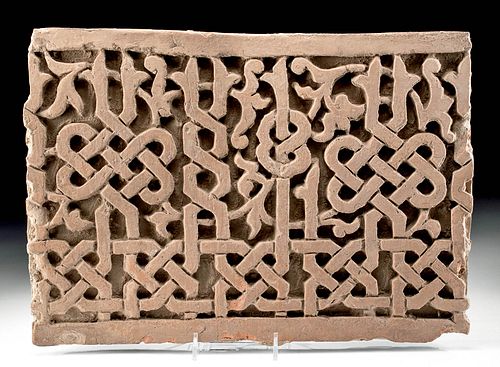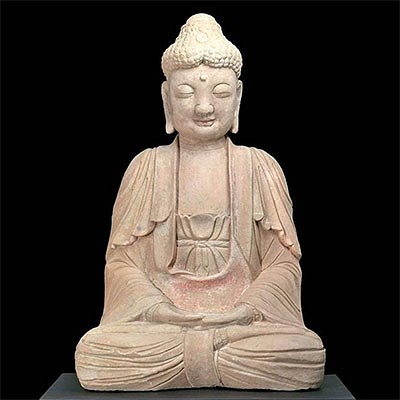Published 12th C. Persian Molded Terracotta Panel
Lot 61c
About Seller
Artemis Gallery
686 S Taylor Ave, Ste 106
Louisville, CO 80027
United States
Selling antiquities, ancient and ethnographic art online since 1993, Artemis Gallery specializes in Classical Antiquities (Egyptian, Greek, Roman, Near Eastern), Asian, Pre-Columbian, African / Tribal / Oceanographic art. Our extensive inventory includes pottery, stone, metal, wood, glass and textil...Read more
Categories
Estimate:
$15,000 - $20,000
Absentee vs Live bid
Two ways to bid:
- Leave a max absentee bid and the platform will bid on your behalf up to your maximum bid during the live auction.
- Bid live during the auction and your bids will be submitted real-time to the auctioneer.
Bid Increments
| Price | Bid Increment |
|---|---|
| $0 | $25 |
| $300 | $50 |
| $1,000 | $100 |
| $2,000 | $250 |
| $5,000 | $500 |
| $10,000 | $1,000 |
| $20,000 | $2,500 |
| $50,000 | $5,000 |
| $100,000 | $10,000 |
| $200,000 | $20,000 |
About Auction
By Artemis Gallery
Feb 18, 2021
Set Reminder
2021-02-18 10:00:00
2021-02-18 10:00:00
America/New_York
Bidsquare
Bidsquare : Exceptional Antiquities, Asian, Ethnographic
https://www.bidsquare.com/auctions/artemis-gallery/exceptional-antiquities-asian-ethnographic-6373
Museum-worthy examples of Egyptian, Greek, Roman, Etruscan, Near Eastern, Far East / Asian, Pre-Columbian, African / Tribal, Oceanic, Native American, Spanish Colonial, Russian, Fossils, Ancient Jewelry, Fine Art, so much more! Artemis Gallery info@artemisgallery.com
Museum-worthy examples of Egyptian, Greek, Roman, Etruscan, Near Eastern, Far East / Asian, Pre-Columbian, African / Tribal, Oceanic, Native American, Spanish Colonial, Russian, Fossils, Ancient Jewelry, Fine Art, so much more! Artemis Gallery info@artemisgallery.com
- Lot Description
Ancient Near East, Persia, 12th century CE. An outstanding molded terracotta tile, quite similar to those of the Mosque of Forumad. Aside from a few organic leaf-like forms, the decorative program abides by Islam's disavowal of representations of living beings in sacred contexts. Given this, we see no animals but rather a mesmerizing composition of abstract geometric and curvilinear motifs. Please note: this piece was published and exhibited at the Malone Gallery of Loyola Marymount University in the 1970s (details below). An incredible piece that demonstrates the merging of art and geometry in this part of the ancient world! Size: 1.7" L x 14.25" W x 10.1" H (4.3 cm x 36.2 cm x 25.7 cm)
For more about the geometric decoration of the Furamad Mosques, see an interesting paper entitled, "Geometric Analysis of Furumad Mosques' Ornaments" (Proceedings of Bridges 2013: Mathematics, Music, Art, Architecture, Culture - authors Professors Mahsa Kharazmi and Reza Sarhangi) for more about the interesting relationship of geometry and abstract imagery of the Mosque of Furumad's decorative program. The abstract reads as follows: "Early mosques were simple buildings with no decoration. After some decades and under the influence of advanced civilizations of conquered territories, architectural ornaments entered into their existence. Since Islamic thought prohibited artists and craftsmen of creating human figures, they turned their attention to abstract forms. They also benefited from mathematics, which flourished in early Islamic period in Baghdad. This resulted to a widespread movement in Islamic geometric art. Even though the designers of those structures had remarkable knowledge of applied geometry, there exist few written records to explain various methods that they employed for constructions of their designs [7]. Nevertheless, based on the detailed and sophisticated geometric designs in these documents we may suggest that some degree of mathematical literacy may have existed among the master builders, architects and master engineers [1]. For creating ornamental designs, the traditional tools of medieval times, a compass, straightedge, and set square, may well have been used by those master builders versed in construction techniques [5]. The architectural elements for decoration created by the artists and artisans of the Seljuq period of 11th and 12th centuries gradually flourished in Iran, central Asia, and North Africa. At first, brickwork was a common approach for creating abstract motifs. Glazed brick gradually entered into architectural ornaments. Forumad was a pioneer in applying glazed brick in Iranian mosques. This structure is a small mosque with its ornaments decorated inside as well as outside walls. Following geometric substructures of ornamental designs in the Forumad mosque, we endeavor to illustrate practical geometry and try to detect design methods, which can be created by common instruments used by the designers and architects at that time."
Published in catalogue for exhibition of Islamic Art at the Malone Gallery of Loyola Marymount University March 8 to April 2, 1976. The piece also appears on the back cover.
Provenance: private California, USA collection; purchased in Semnan, Iran in 1971 - 1972
All items legal to buy/sell under U.S. Statute covering cultural patrimony Code 2600, CHAPTER 14, and are guaranteed to be as described or your money back.
A Certificate of Authenticity will accompany all winning bids.
We ship worldwide and handle all shipping in-house for your convenience.
#155862Small losses from peripheries as shown. Great deposits on surface, mostly on the back, with excellent preservation of motifs.Condition
- Shipping Info
-
All shipping is handled in-house for your convenience. Your invoice from Artemis Gallery will include shipping calculation instructions. If in doubt, please inquire BEFORE bidding for estimated shipping costs for individual items.
-
- Buyer's Premium



 EUR
EUR CAD
CAD AUD
AUD GBP
GBP MXN
MXN HKD
HKD CNY
CNY MYR
MYR SEK
SEK SGD
SGD CHF
CHF THB
THB














